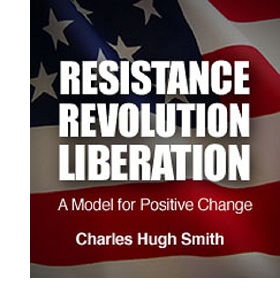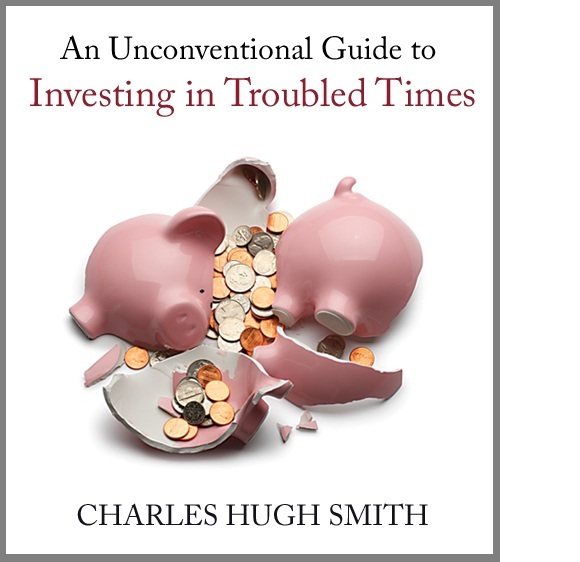

|

|
|||||||||||||
|
By Incentivizing Debt, We've Guaranteed Debt-Serfdom and Stagnation (June 12, 2012) Incentivize debt and you create multiple overlapping death spirals. The incentives to take on debt are so ubiquitous that we underestimate their pernicious power to trigger self-destructive behavior. Want to go to college? Just borrow the money now, with no payments until you graduate. Need some consumerist-retail therapy to lift your sagging spirits? Just use plastic, and pay for the splurge later. Want to buy a house? Hey, the interest on that 30-year mortgage is all tax deductible. It's crazy to pay taxes when there's a big fat deduction for mortgage interest. This same set of incentives works on a national and global scale, too. Put yourself in the shoes of the typical spineless, campaign-donation-dependent politico whose primary obsession in life is clinging to power via winning the next election. Every heavy-weight constituency is protesting any tiny reduction in their share of the Federal swag, so drastic cuts are out of the question. What's the only painless option? Borrow $1.5 trillion every year to make sure the swag is fully funded and the restive constituencies are quieted for another election cycle. But debt has a consequence called interest that feeds a destructive self-reinforcing cycle. At a certain threshold, there is no painless way to pay the interest except to borrow more money. That increases the interest payments due next year, and so the "solution" is to borrow yet more next year. As I explain in Resistance, Revolution, Liberation: A Model for Positive Change, the Status Quo has relied on "growing our way out of debt" to overcome this cycle: if the new debt fuels a rise in productivity, the economy will grow so much faster than the debt that the relative burden of the debt actually declines. In a simple example, if a $1 trillion economy borrows $1 trillion and invests it such that the economy rapidly expands to $5 trillion of goods and services, then the rise in national income means the interest on the $1 trillion can be paid out of the huge increase in income generated by the rising productivity. The same is true for a company that borrows what appears to be a large sum in order to boost production. If revenues leap from $100 million to $1 billion as the result of a $100 million investment, the interest can be paid out of the higher cash flow. The wheels fall off the "growing our way out of debt" strategy if the borrowed money was spent on consumption or invested in low-productivity purposes. After it's all said and done, the money's gone but the debt remains and the interest is still due. This is where the housing bubble enters the picture. Given that mortgage interest (even the interest on home equity lines of credit, HELOCs) is deductible, then it was incredibly attractive for those with equity to borrow that equity for consumption, an addition/remodel or to fund another home purchase as an investment or vacation get-away. Since the additional debt did not create any additional income, more of the household's income is now diverted to paying interest. Even if the additional debt was used to purchase a rental property, if that property's expenses (property taxes, maintenance, etc.) have outpaced rental income increases, or the equity in the rental was extracted in the bubble, then the actual rise in net income might be negligible or even negative. I know a number of households with substantial real estate assets and upper-middle class incomes, but they are effectively low-income debt-serfs, as most of their income goes to the interest payments on their stupendous mortgages. Now that they're heavily mortgaged, banks won't lend them more money, nor will they refinance exisiting mortgages: these heavily indebted households are now credit risks. 15% equity on $2 million in property looks like there's a net household worth of $300,000, but it's dead money, i.e. trapped capital: it cannot be tapped except by selling the property. And since property values have fallen significantly from the top, most households are loathe to sell at depressed prices. Meanwhile, the majority of household income goes to mortgage payments, leaving little to save, invest or enjoy. This is how high-income households enter debt-serfdom. On paper, they're still worth a lot, but it's trapped capital. On paper, they have a substantial income, but since $50,000 of it (or even $100,000 or more if the household owns multiple properties) goes to mortgage interest, their actual net income is modest or even negative. This is why so many households have pulled money out of IRAs and 401K retirement funds: their debt service costs and essential expenses exceed their income. It's also why income tax revenues are lower than they were "in the good old days" before the bubble popped. As median household incomes have declined 9.9% since December 2007, there is less income to tax, and large mortgage payments have reduced taxable income to mere trickles even in high-income households. Whenever I discover a well-off friend is paying minimal Federal and State taxes, I ask, what's the trick? Answer: huge mortgage payments. The trapped-capital equity in real estate is simply another form of phantom wealth. If too many people try to free that trapped capital by selling, the price of real estate will decline and the actual net equity left after commissions might well be near-zero. Recall there are at least 6 million homes in the shadow inventory and 12 million "underwater" households whose mortgage exceeds the market value of their house. Since they can't sell, they are debt-serfs, indentured to their mortgages and the owners and servicers of those mortgages. This same dynamic plays out in heavily indebted nations. Take Japan, for example. Its national tax revenues barely cover its interest payments and social security program, despite interest rates below 1%. The rest of its government expenditures must be borrowed, adding to next year's interest payment burden. Once a critical mass of income is devoted to paying interest, there is not enough income left to invest in productive investments. Without increases in productivity, income declines, further squeezing budgets as income falls but debt service costs remain fixed. As the relative share of income siphoned off by interest rises, there is less available for either investment or consumption, so "growth" also declines. Borrowing more to pay the interest only adds to next year's interest payments. Incentivize debt, and you end up relying on debt as a sustitute for productivity and income. Increase debt, and there's not enough income left for productive investments that might boost income. Incentivize debt via making interest tax deductible, and you create a self-reinforcing feedback of a rising share of declining income being devoted to interest payments. With demand and borrowing both suppressed by debt-serfdom, demand for housing, goods and services declines. Borrowing more to consume simply speeds the cycle of rising interest and falling net incomes. Incentivize debt and you create multiple overlapping death spirals. We are seeing the death-spirals play out in a fractal manner, from households to nations to entire regions. High debt levels lead to high interest payments which lead to low investment and savings rates which lead to lower productivity which leads to stagnation of income, consumption and investment: in other words, a death spiral.
 Resistance, Revolution, Liberation: A Model for Positive Change
(print $25)
Resistance, Revolution, Liberation: A Model for Positive Change
(print $25)
(Kindle eBook $9.95) Read the Introduction (2,600 words) and Chapter One (7,600 words) for free.
We are like passengers on the Titanic ten minutes after its fatal encounter with the iceberg: though our financial system seems unsinkable, its reliance on debt and financialization has already doomed it.

If this recession strikes you as different from previous downturns, you might
be interested in my book
An Unconventional Guide to Investing in Troubled Times (print edition)
or
Kindle ebook format. You can read the ebook on any
computer, smart phone, iPad, etc. Click here for links to Kindle apps and Chapter One.
The solution in one word: Localism.
Of Two Minds Kindle edition: Of Two Minds blog-Kindle

"This guy is THE leading visionary on reality.
He routinely discusses things which no one else has talked about, yet,
turn out to be quite relevant months later."
NOTE: gifts/contributions are acknowledged in the order received. Your name and email remain confidential and will not be given to any other individual, company or agency.
Or send him coins, stamps or quatloos via mail--please request P.O. Box address. Subscribers ($5/mo) and contributors of $50 or more this year will receive a weekly email of exclusive (though not necessarily coherent) musings and amusings. At readers' request, there is also a $10/month option. The "unsubscribe" link is for when you find the usual drivel here insufferable.
All content, HTML coding, format design, design elements and images copyright © 2012 Charles Hugh Smith, All rights reserved in all media, unless otherwise credited or noted. I would be honored if you linked this essay to your site, or printed a copy for your own use.
Terms of Service:
|
Add oftwominds.com to your reader:
My Big Island Girl
Instrumentals by my friend
|
| Survival+ | blog fiction/novels articles my hidden history books/films what's for dinner | home email me | ||